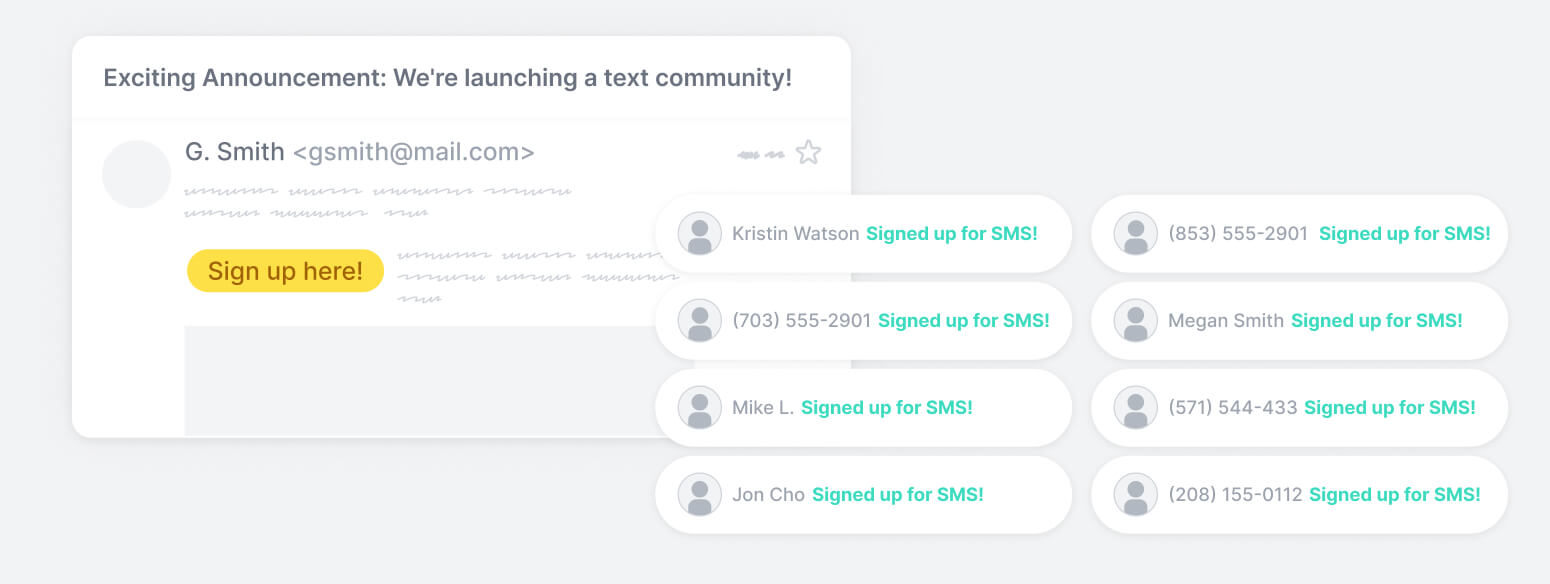
SMS vs. Email Marketing: Which Is More Effective?
Looking to foster community around your brand? SMS and email marketing are two of the most effective channels to do it. You might already use one or both, but still be unsure how to maximize performance—or you may be reevaluating your strategy due to shifting budgets. Whatever the case, investing in the right channel can make or break your ability to drive engagement and loyalty.
This guide breaks down the latest data and insights to help you choose between SMS and email marketing. The choice isn’t always black and white, but when revenue and retention are on the line, your marketing mix should be built around channels that deliver real results.
Key Takeaways
SMS marketing is generally more effective than email when it comes to engagement and conversions, though both channels serve distinct purposes.
- Higher performance: SMS averages a 98% open rate and 29% conversion rate, compared to 39% and 15% for email.
- Better engagement: Click-through rates for SMS hover around 6%, versus roughly 2–3% for email.
- Different strengths: Email supports long-form storytelling; SMS drives immediate action.
- Best results: Combining SMS and email maximizes reach and customer retention.
What Is SMS Marketing?
SMS (short message service) marketing is a marketing strategy powered by direct communication that sends targeted content, promotions, and/or updates to customers via text. Unlike other marketing channels, SMS creates a personal connection with your audience because it lands directly in the space they reserve for trusted contacts. Modern SMS marketing often leverages sophisticated customer segmentation—a tactic where you group recipients based on their interests, behaviors, or preferences.
Smart SMS marketing forgoes one-way broadcasting and opts for genuine, two-way conversations through a direct line of communication with your customers and audiences to promote your brand and foster loyalty.
It’s a simple way to directly get in touch and converse with your target audience. Purpose-built platforms like Subtext optimize for communications like these.
What Is Email Marketing?
Email marketing is a cornerstone of digital marketing that focuses on nurturing relationships through anything from newsletters to promotional offers to product announcements and more. As with SMS marketing, you can segment your email contacts based on preferences and interests, or where they are in the sales funnel.
While email excels at delivering comprehensive information, email inboxes are more crowded than ever—more than 376.5 billion emails are exchanged every day. Standing out from this crowd takes work. When it comes to SMS vs. email, the latter’s strength primarily lies in its ability to convey lengthy or complex information, not necessarily in community engagement.
Email provides depth of content. SMS cultivates depth of relationships.
SMS Marketing vs. Email Marketing: 3 Factors Worth Considering
When comparing SMS and email marketing side by side, metrics reveal the true performance gap. These factors focus on metrics that play key roles in community building and impact:
1. Open Rates
The difference between SMS open rates vs. email speaks for itself. While emails have an average open rate of 39%, SMS marketing has an incredible 98% average open rate. In addition, it usually takes people around 90 minutes to open an email. With SMS, users open the message within 90 seconds.
These aren’t just vanity metrics. Higher open rates mean SMS marketing reaches customers far more quickly and reliably. Still, email isn’t obsolete here. Those who do choose to open emails are often some of your most engaged subscribers. For time-sensitive promotions and direct messaging, however, the near-universal open rate of SMS is a major competitive advantage.

Experience 98% open rates firsthand. See the difference between SMS and email for engagement when you use a platform like Subtext.
2. Engagement Levels
When measuring engagement, click-through rates (CTR) are a key indicator of how well your audience is responding to your message. Looking at CTRs with SMS and email marketing reveals a clear difference in audience interaction.
Because SMS messages are shorter and usually have only one clear call to action, the average CTR is 6.1%. Emails have only a 2.6% average CTR, likely because they require more attention and investment on the user’s end. These metrics explain why sophisticated SMS platforms are gaining traction with forward-thinking marketers. The chart below breaks down Subtext’s CTR compared to email across top industries like media, music, sports, and events.
.png?width=520&height=389&name=CTR%20Benchmarks%20Graph%20(1).png) Subtext’s platform outperforms industry standards, with creators seeing 13x higher CTR compared to email and 5x the SMS industry standard. This performance translates directly to business results and engagement.
Subtext’s platform outperforms industry standards, with creators seeing 13x higher CTR compared to email and 5x the SMS industry standard. This performance translates directly to business results and engagement.
The simplicity of SMS—one message, one link, one action— eliminates decision fatigue and drives immediate audience interaction. The best part: Incorporating SMS alongside email can boost engagement for both channels thanks to timely reminders and updates, giving marketers a more well-rounded, highly engaging strategy.
3. Conversion Rates
Here’s where the difference between SMS vs. email marketing really shines. SMS carries an average conversion rate of 29%, while email has a 15.2% average conversion rate. More significantly, SMS generates 17 times more revenue than email. This cements it as an essential channel for revenue-focused organizations.
SMS marketing is the clear winner when it comes to garnering results because it’s personal and accessible. When subscribers receive a text from a brand they trust, they’re primed to act.
With Subtext, these statistics can be your reality. Start capturing conversions with the power of SMS.

The Advantage Analysis of SMS and Email Marketing
The performance metrics make a compelling case for text messaging, but both SMS and email have distinct advantages and disadvantages for your marketing strategy. Let’s take a closer look at both sides.
SMS Marketing Advantages
- Is fast, convenient, and common. SMS leverages the most habitual communication method—people send four times more text messages than emails every day. It’s quick and easy.
- Offers personal connection. SMS allows you to engage subscribers in a space reserved for people they trust. This is crucial in a world where people are inundated with information and communication. SMS allows you to build smarter, more direct, and more productive feedback loops.
- Generates more ROI. Beyond the 17x revenue advantage over email, SMS marketing requires minimal design resources and faster deployment compared to email. It’s unmatched in terms of cost and time to market.
- Provides two-way communication capability. SMS allows for interactive communication between both parties involved. This enables you to receive quick and direct feedback from the recipient and engage with them in real-time.
- Prioritizes mobile-first accessibility. With 98% of Americans owning a mobile device and 95% of texts read within minutes, SMS meets customers where they already are. Most importantly, it respects modern attention spans with concise, purposeful messages.
SMS Marketing Considerations
- Sourcing phone numbers can be difficult. People don’t hand out their digits frivolously. It can take some time to move prospective subscribers further down the funnel to gain their trust and obtain opt-in permission. However, this barrier can result in more engaged, valuable subscribers.
- Must consider strict mobile carrier guidelines. Mobile carriers have strict guidelines on how to utilize SMS. To ensure compliance, all 10DLC traffic must be registered via The Campaign Registry (TCR). TCR verifies your organization is legitimate and assigns a trust score. Fortunately, with professional platforms like Subtext, compliant delivery is effortless.
Read more about how Subtext makes it easy to navigate SMS compliance.
Email Marketing Advantages
- Message length. Email marketing allows you to fit in more word count, helping teams execute more detailed communication. This can be particularly useful for conveying complex ideas or concepts.
- Long lifespan. Recipients can easily save an email or mark it as important. With the vast inbox search functions, users can always find a message when they need it.
- Access to layout options. Thanks to the numerous layout options on email platforms, you can add useful graphics and media elements to engage users.
Email Marketing Limitations
- Can be difficult to stand out and make a real impact. Let’s put things in perspective—a person receives, on average, 121 emails each day. Your email is likely a tiny pebble in a large world. This is a significant engagement challenge.
- Takes time to build a quality, eye-catching email. Emails take quite a bit of time to write and design. This requires the help of copywriters and designers. You may also need to factor in A/B testing, which adds even more time. This is time and money you often can’t afford to lose.
- Lacks quick two-way communication. Unlike SMS, email marketing generally does not have direct and immediate two-way capability. Building a personable and instant messaging relationship can be more difficult to build compared to SMS. If you're looking for immediate responses, email marketing may not be the ideal solution.
SMS Marketing vs. Email Marketing: Which Is Right for You?

With countless organizations vying for their attention, users today are overloaded with information on their devices. There isn’t a one-size-fits-all approach in the world of marketing. It’s not a matter of choosing one or the other—it's about how you leverage channels in a way that elevates the intent and values of your community.
Email for Discovery
Use email to provide detailed information, nurture relationships, and build initial trust. Consider email for weekly newsletters and long-form content. You can even use your email channel to generate SMS subscriber sign-ups.
SMS for Action
Deploy SMS for time-sensitive offers, exclusive alerts, and direct subscriber engagement. Consider text messaging for things like flash sales and updates that make subscribers feel like insiders. SMS offers lucrative opportunities to nurture relationships with those who matter most to your business.
Cross-Channel Growth
Both SMS and email marketing can be cost-effective ways to deliver your message and build a community of like-minded consumers. In today’s fast-paced world, it’s critical to be strategic when investing in marketing channels. One channel can elevate another—and together, they can give you a quality, complementary marketing strategy.
At Subtext, high-converting SMS campaigns are what we’re built for. See how adding sophisticated SMS to your marketing mix can amplify your community-building objectives.
SMS vs. Email Marketing: Fuel Your Efforts with Subtext
Both SMS and email marketing channels can help you boost your brand. When it comes to community building, leading brands know where to look. Building a successful SMS community requires more than sending messages—it demands creative continuity and personalization. Luckily, you’re in the right place.
Subtext provides the tools you need to create authentic connections with your audience. Our platform was built with impactful SMS features designed to help you build lucrative, lasting relationships. Explore Subtext today by booking a demo.